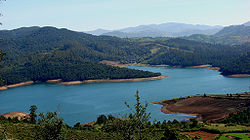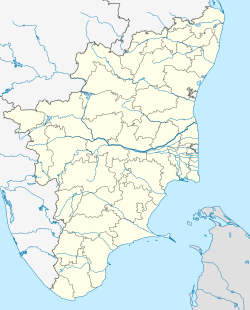Ooty( The Queen Of Hill Stations)
| Udagamandalam Ooty | |
|---|---|
| Hill station | |
 | |
| Nickname(s): Queen of Hill Stations | |
| Coordinates: 11.41°N 76.70°ECoordinates: 11.41°N 76.70°E | |
| Country | India |
| State | Tamil Nadu |
| District | The Nilgiris |
| Government | |
| • Type | Special Grade Municipality |
| • Body | Udagamandalam Municipality |
| Elevation[1] | 2,240 m (7,350 ft) |
| Population (2011)[2] | |
| • Total | 88,430 |
| Languages | |
| • Official | Tamil |
| Time zone | IST (UTC+5:30) |
| PIN | 643 001 |
| Tele | 91423 |
| Vehicle registration | TN-43 |
| Civic agency | Udagamandalam Municipality |
| Climate | Subtropical Highland(Köppen) |
| Precipitation | 1,238 mm (49 in) |
| Avg. annual temperature | 14.4 °C (58 °F) |
| Temperature from Batchmates.com[3] | |
Ooty (queen of hill stations)
udagamandalam (also known as Ootacamund ), and abbreviated as Udhagai or Ooty, is a town and municipality in Tamil Nadu, India. It is located 86 km north of Coimbatore and 128 km south of Mysore and is the capital of the Nilgiris district. It is a popular hill station located in the Nilgiri Hills.
Originally occupied by the Toda people, the area came under the rule of the East India Company at the end of the 18th century. The economy is based on tourism and agriculture, along with the manufacture of medicines and photographic film. The town is connected by the Nilgiri ghat roads and Nilgiri Mountain Railway. Its natural environment attracts tourists and it is a popular summer destination.[4] In 2011, the town had a population of 88,430.[2]
History
Udagamandalam was originally a tribal land occupied by the Toda and Badagas along with other hill tribes who coexisted through specialisation and trade. The major tribes of Nilgiris area are the Toda, Kota, Irula and Kurumba.The Baduga langague is a dilect of Kannada.
The Toda in the Nilgiris are first referenced in a record belonging to Hoysala king Vishnuvardhana and his general Punisa, dated 1117 CE.[9] The Toda people were known for raising water buffalo. The Badaga people known for farming activities.[10] Nilgiris was ruled by various dynasties like Satavahanas, Gangas, Kadambas, Rashtrakutas,Hoysalas, the Vijayanagara empire and the Rajas of Ummattur (on behalf of Wodeyars of Mysuru).[9][11][12][13][14] Tipu Sultan captured Nilgiris in the eighteenth century and extended the border by constructing a hideout cave-like structure.[10] The Nilgiris came into possession of British East India Company as part of the ceded lands, held by Tipu Sultan, by the treaty of Srirangapatnam in 1799.
In 1818, J. C. Whish and N. W. Kindersley, assistants to John Sullivan, then Collector of Coimbatore, visited Ooty and submitted a report to him. Sullivan camped at Dimbhatti, north of Kotagiri in January 1819 and was enthralled by the beauty of the place. He wrote to Thomas Munro, " ... it resembles Switzerland, more than any country of Europe... the hills beautifully wooded and fine strong spring with running water in every valley."[15] The Toda ceded that part of the town to Sullivan and in May 1819, he began to build his bungalow at Dimbhatti. He also started work on a road from Sirumugai to Dimbhatti that year. The road was completed in May 1823, and extended up to Coonoor by 1830-32.[5]
Ooty served as the summer capital of the Madras Presidency; it was visited by British officials during the colonial days as a popular summer resort.[16] Soldiers were sent to nearby Wellington to recuperate. Wellington is the home of the Madras Regiment of the Indian Army.[17][18] After Independence, it developed into a popular hill resort.
Gardens and parks[edit]
The Government Rose Garden (formerly Centenary Rose Park)[24][25] is the largest rose garden in India.[26] It is situated on the slopes of the Elk Hill in Vijayanagaram of Ooty town.[27] at an altitude of 2200 meters. Today this garden has one of the largest collection of roses in the country with more than 20,000 varieties of roses of 2,800 cultivars.[28] The collection includes hybrid tea roses, Miniature Roses, Polyanthas, Papagena, Floribunda, Ramblers, Yakimour and roses of unusual colours like black and green.
The 22-acre (89,000 m2) Ooty Botanical Gardens was laid out in 1847[29] and is maintained by the Government of Tamil Nadu. The Botanical Garden is lush, green, and well-maintained. A flower show along with an exhibition of rare plant species is held every May. The gardens have around a thousand species, both exotic and indigenous, of plants, shrubs, ferns, trees, herbal and bonsai plants.[30] The garden has a 20-million-year-old fossilised tree.[31][32]
Deer Park is located on the edge of Ooty Lake. It is the highest altitude zoo in India aside from the zoo in Nainital, Uttarakhand. This park was formed to house a number of species of deer and other animals.[33]





Comments
Post a Comment